Like smartphones and other battery-powered devices, laptops go to sleep to conserve energy. But you might notice your machine hitting the sack in the middle of work, for no apparent reason other than bringing another device too close. No, the battery didn’t die; it’s much simpler.
There are a few ways to manually put your laptop into sleep mode. On a Mac, you can click the Apple logo in the top right and choose “Sleep.” On most laptops — Mac or PC — you can press the power button to do the same (macOS may bring up the Lock Screen for a minute before going to sleep). Of course, the method most often used is to just close the laptop lid. Once the device is in clamshell mode, it automatically goes to sleep.
But therein lies the problem. Your laptop uses magnets to keep itself securely shut, but those magnets also let it know when the lid is closed. When the top of the lid gets close enough to the base of your laptop, it triggers sleep mode. That’s why, for many laptops, you can get it to sleep even before the lid is fully shut. These magnets are often strong enough to hold up AirPods, too (just be sure they aren’t there when you slam the lid shut).
However, your laptop doesn’t know the difference between the magnets in the lid and magnets in other devices. An iPad, for example, contains magnets for attaching smart devices. When you bring your iPad’s magnets close enough to the base of your laptop, it thinks your iPad is really the lid, and goes to sleep.
You can see the issue in action from this Reddit post. OP was confused as to why their laptop would turn off whenever their iPad got too close. The answer is, as we now know, magnets (how do they work)?
How to change how often your laptop goes to sleep
Perhaps your laptop is still going to sleep on its own with no magnetic device to be found. In that case, I’d recommend diving into your computer’s power settings to see if you have a sleep timer set up. My Mac will go to sleep after 30 minutes of inactivity, but you can set that timer to as little as one minute. While that won’t affect things when you’re actively typing, you might be surprised how often you go without hitting a key or moving the cursor. If your sleep timer is short enough, it could be the culprit.
On a Mac, you’ll find the option in System Settings > Lock Screen (macOS Ventura) or System Preferences > Battery or Energy Saver. On Windows, head to Start > Settings > System > Power & battery > Screen and sleep (Windows 11) or Start > Settings > System > Power & sleep (Windows 10).

Leave a Reply
You must be logged in to post a comment.